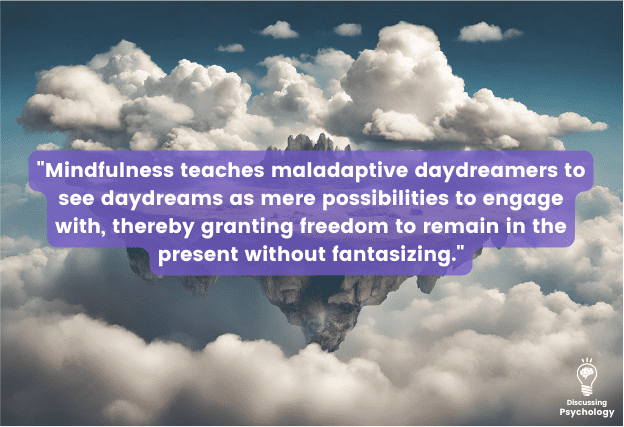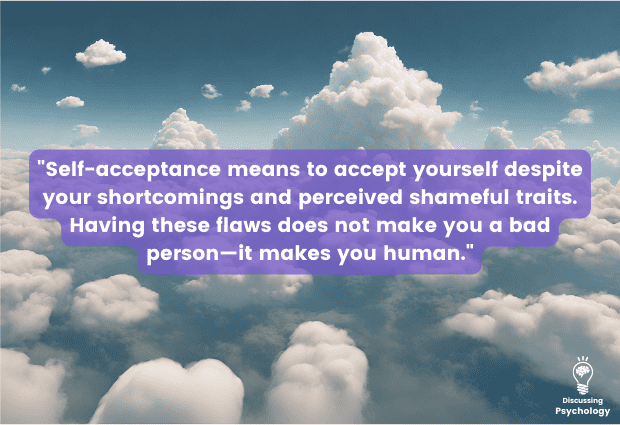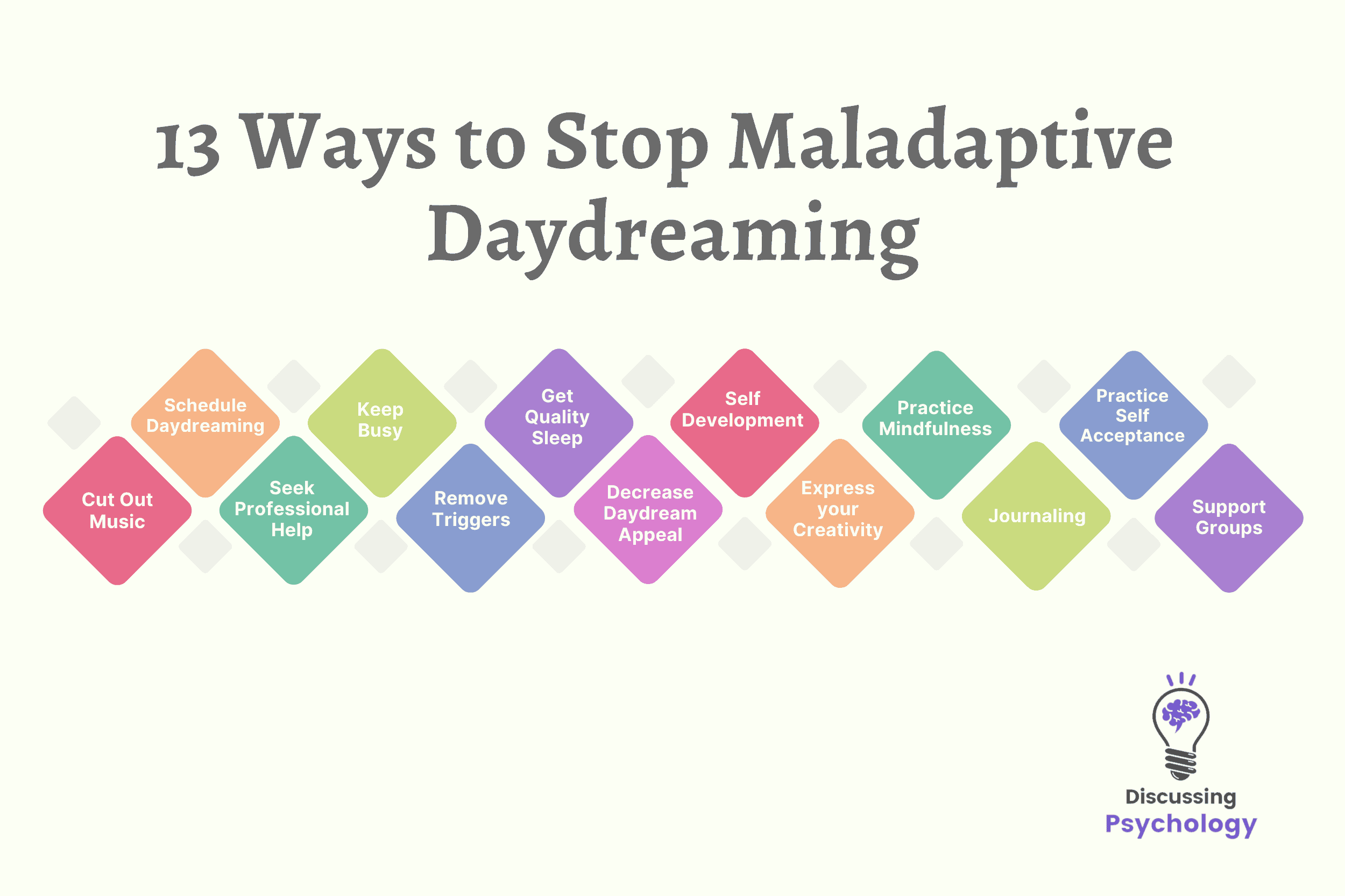Maladaptive daydreaming (MD) can cause an intense amount of shame, isolation and impairment to daily functioning.
If you suffer from it, deciding to break your daydreaming habit probably sounds like a no-brainer. But the path to stopping maladaptive daydreaming isn’t quite so clear.
Below, we’ll take you through our 13 point checklist for reducing symptoms of MD, all of which are based on research or gathered from ex-maladaptive daydreamers themselves.
How to Stop Maladaptive Daydreaming: 13 Ways to Regain Control
The best way to stop maladaptive daydreaming is to hit it from multiple angles.
You need to remove the conditions that facilitate your fantasy time while strengthening your ability to resist the urge to daydream by learning new mental skills.
Keeping yourself accountable through professional help or peer support is also essential.
Below we’ll explore 13 different methods you can employ in each of these areas, taken from research into MD treatment and from what other maladaptive daydreamers have found to help.
These methods include:
- Spend less time listening to music
- Set aside a specific time for daydreaming
- Find professional help
- Keep busy
- Remove the conditions for daydreaming
- Work on your sleep quality
- Make your daydreams less appealing
- Self-development
- Embrace other forms of creativity
- Practice mindfulness
- Journaling
- Practice self-acceptance
- Find group support
Ready to put your foot down and make a change? Let’s get to it.
Related: If you haven't already, you can take our free online maladaptive daydreaming test which is based on the official MDS-16.
1. Cut out music and headphone use
With most addictions, there is a trigger, a situation, thought or feeling that makes you want to engage in your habit.
Remove the trigger, and you reduce the likelihood of slipping up.
For many people with MD, music unlocks the door to their fantasy lives. Without certain songs or sounds to engage their imagination, it’s harder to get into the zone and stay there for long periods.
So, a first step in overcoming MD is to stop listening to music that triggers your daydreams.
What would that look like for you on a practical level? Do you need to throw out your headphones or lock them in a drawer? Could you cancel your subscription to whatever music streaming service you use, or (if you’re old school) hide your CDs? If certain kinds of music facilitate your daydreams, could you start deliberately listening to other kinds of music? (eg: substituting lyrical music with instrumentals).
You’ll never be able to totally cut music out of your life, but you can make engaging with your trigger music harder, giving you a better chance of fighting the urge to daydream before it takes over.
2. Set aside a specific time for daydreaming
This might sound counterintuitive, but part of the problem with daydreaming is that it’s technically always possible to stop paying attention to the real world and slip into fantasies.
If you give yourself a specific time each day set aside for daydreaming, it becomes easier to fight the urge during the rest of the day.
Try to find a fixed time each day and stick to it as closely as you can. When you feel the urge to daydream during the day, tell yourself you just have to wait until the allotted time and turn your focus back to the present moment.
This is much easier than quitting cold turkey and helps you gain a sense of control over your daydreams.
3. Find professional help
If overcoming maladaptive daydreaming feels like too much to manage alone, support from a professional therapist could be a great option.
There are no official treatment methods for MD as of yet, but a therapist can still guide you through the change process, offer suggestions on what to do, and give you a safe space to explore your thoughts and feelings as you go.
If you’re one of the many daydreamers who has endured trauma or difficult life circumstances, taking the brave step of seeking out therapy can help you resolve these long-buried hurts and find a place of peace.
Treatment types such as:
- Cognitive behavioral therapy (CBT)
- Dialectical behavior therapy (DBT)
- Mindfulness-based stress reduction (MDBR)
Can all help you heal from your past and improve your ability to face life’s challenges without the need for daydreaming.
It’s also important that you find a therapist who understands MD and is willing to work with you in overcoming it.
Talking to a therapist about maladaptive daydreaming is nothing to feel ashamed of. BetterHelp has over 30,000 licensed therapists who can provide a safe space to explore your feelings, deal with compulsive thoughts and help challenge unhealthy coping mechanisms. Prices starting at $65/week. To get started with BetterHelp online therapy, click here to fill in their brief questionnaire. Discussing Psychology readers get 15% off their first month with BetterHelp.
4. Keep busy

Filling your daily schedule with as many fun, interesting activities as possible helps you combat MD on two levels.
First, most daydreamers agree that it’s nearly impossible to daydream when you’re with other people or focused on an important task, so the less time you spend alone or unoccupied, the easier it will be.
Second, a busy, active schedule can also help you find meaning and enjoyment in your real life, meaning you have less desire to resort to daydreams to feel okay.
Maladaptive daydreaming and isolation go hand in hand.
So, start saying yes to things and invitations: get out there and throw yourself into life like never before.
5. Remove the conditions for maladaptive daydreaming
Unhealthy habits like maladaptive daydreaming tend to breed and fester when we create space for them and adapt our lives around them. So, it’s time to stop doing that.
Identify typical routines or things in your environment or life that cause you to daydream.
For example, do you tend to daydream excessively during long walks to the shops, gym or work?
If so, you could try distracting yourself by listening to a podcast, practicing mindfulness or altering your schedule to minimize alone time during these periods.
6. Work on your sleep quality
MD can make getting a good night’s sleep harder, and when you’re tired it’s much harder to fight the urge to daydream the day away.
It isn’t easy, but prioritizing a good night’s rest can give you the strength you need to keep your mind on track.
Improving sleep quality is a big topic in itself, but often revolves around establishing peaceful bedtime routines and getting yourself into a relaxed frame of mind before bed.
Our article on maladaptive daydreaming at night is a good place to start fact finding.
7. Make your daydreams less appealing
The fact that you have direct control over the content of your daydreams can be a useful tool in cutting them out.
If you work on making your dream world a less enjoyable place to spend time, you’ll naturally devote less and less time to it.
Repetition is the key here. Each time you feel the urge to daydream, imagine something that makes it a less attractive idea.
The exact details depend on your individual dream life: you might want to try steering your dream life towards a dull, boring plot that’s no fun to spend time on.
You could try bringing your dream narrative to a definitive end, or even killing off characters to make further stories impossible.
This might seem like quite a drastic approach, but it can be very effective if you stick with it.
8. Stopping maladaptive daydreaming through self-development
Lifestyle adjustments that make it harder to engage in daydreaming are a great first step.
It can also be helpful to work on learning some new tricks and skills to strengthen your mind and learn to cope with challenges without resorting to fantasy.
When you’re the best version of yourself and operating at your potential, you’ll feel less inclined to escape into daydreams to compensate for lack of real-world success.
So try your hand at self-development—it’s a long-term game, but if you stick with it, the rewards can pay back in dividends.
It's also worth noting there's a fine line between needing self-development/personal coaching vs requiring therapy for mental conditions. You can read more about the differences between therapy and coaching in our piece comparing BetterHelp and BetterUp, both of which are leading services in the wellness space.
9. Embrace other forms of creativity
One of the prerequisites of maladaptive daydreaming is having a vivid imagination and the ability to become fully absorbed in creative thought.
Neither of those things are bad in themselves; in fact, they can be very desirable traits if you can channel them in the right direction.
Many people with MD use it as a source of fun and enjoyment when other areas of life are dull and unrewarding.
But it’s entirely possible to get the same rewarding sense of ‘flow’ and satisfaction from other forms of creativity.
What other kinds of creativity are you interested in? Could focusing your time on hobbies, artistic pursuits, or other passions give you a better outlet for your imagination? Your capacity for imagination is a real asset.
Applying it to your real life can be extremely rewarding and may help you find a sense of purpose outside of your fantasy life.
10. Train your mind with mindfulness
Mindfulness, or the practice of observing your thoughts without judging or acting on them, is something that’s recommended as part of treatment for many other mental health disorders including generalized anxiety and depression.
The reason is that it’s very effective at helping you reign in unwanted or unhelpful thoughts.
Mindfulness helps you focus your attention on the present, letting you get more out of real life and making it easier to shut out the thoughts telling you to daydream.
It also helps you see thoughts as mere suggestions, not things you have to act upon.

So, when the urge to daydream does arise, you don’t have to act on it.
Mindfulness is also great for reducing stress and improving sleep, so it comes highly recommended.
You can start with mindfulness using meditation apps or playlists, many of which are available freely. It’s a skill that requires practice, so start working it into your daily schedule.
11. Journaling
There’s a surprising amount of power in putting your thoughts down on paper.
It can help you express ideas in your head and organize them into something you can actually use.
Writing down your fantasies can have this effect, causing them to take up less space in your head.
It can also be useful to track your progress in overcoming MD in a diary or journal.
Looking back over your notes can give you insight into good and bad days and what works and what doesn’t.
12. Practice self-acceptance
In your fantasies, you might be liked and accepted by everyone around you. You might be a powerful hero in a fantasy land.
It might be hard to be positive about your real self when you spend so much time thinking about an ideal version of you.
However, the more you can learn to be content with who you are, the less you’ll need to fantasize about being better.

Self-acceptance is a huge topic, and something most people search for their whole lives. You can start by looking into positive affirmations and guided self-compassion meditations online and learn new skills or hobbies you can take pride in.
You also need to remind yourself that everyone makes mistakes, and everyone has things they don’t like about themselves.
You don’t have to be the center of the universe to be acceptable in the real world. Being less than perfect is still good enough.
13. Finding support for maladaptive daydreaming
Bad habits often need you to stay silent about them in order to keep a hold on you.
It’s easy to talk yourself into doing something you know you shouldn’t do if no one else will find out.
It isn’t easy, but bringing your daydreaming secret out into the open is a huge positive step in overcoming the condition.
There are a few different ways this could look:
i) Join a support forum
If you thought you were alone in dealing with maladaptive daydreaming, think again.
There are many vibrant online MD communities that can offer support and guidance on managing the condition.
Websites and forums such as:
Can all be great places to look if you want to talk to people who understand your day-to-day challenges and hear tips on what has worked for others trying to control their daydreaming.
Remember that people on these forums aren’t professionals, so don’t take their advice as set in stone and always do your own research too.
ii) Have an accountability partner
Most forms of addiction recovery suggest having a trusted confidant who you keep up to date on your progress.
This could be someone else with MD, or a trusted friend who understands your condition.
It becomes a lot harder to give in to daydreaming when you know you’ll have to tell your confidant about it later.
They’ll also be there to offer you support and encouragement when you’re finding the journey hard.
Are you ready to get rid of maladaptive daydreaming?
We’ve covered a lot of different ways to deal with maladaptive daydreaming.
Following each of the 13 tips above can give you a very good chance of regaining control of your thoughts and your mind.
Learning to manage MD isn’t an easy, straightforward path. It’s a learning process, and failing is part of that process.
Each time you slip up and go back to your fantasy life, don’t beat yourself up or give up.
Instead, use it as a learning opportunity. What went wrong? Did something trigger the daydreaming? How can I avoid it in the future?
By taking this mentality you turn setbacks into powerful moments of growth. And remember, you don’t have to do any of this alone.
Next steps
Maladaptive daydreaming often starts in childhood. It’s usually deeply engrained and almost feels like it’s a part of you.
That’s why often the idea of tackling it all by yourself can sometimes feel daunting or even impossible.
Seeking professional help is nothing to be ashamed of.
If you’d like to get support from an online therapist, we highly recommend BetterHelp.
They have over 30,000 licensed therapists who can provide a safe space for you to explore your thoughts and offer guidance where needed.
To get started with BetterHelp online therapy, click here to fill in their brief questionnaire.
Prices starting at $65/week. Therapy is 100% online. Cancel at anytime.
- Ferrante, E., Marino, A., Guglielmucci, F., & Schimmenti, A. (2022). The mediating role of dissociation and shame in the relationship between emotional trauma and maladaptive daydreaming. Psychology of Consciousness: Theory, Research, and Practice, 9(1), 27–39. https://doi.org/10.1037/cns0000253
- Somer, E. (2018). Maladaptive daydreaming: Ontological analysis, treatment rationale; a pilot case report. Frontiers in the Psychotherapy of Trauma and Dissociation, 1, 1–22. https://www.researchgate.net/publication/322152657_Maladaptive_Daydreaming_Ontological_Analysis_Treatment_Rationale_a_Pilot_Case_Report
- Somer, E., Brenner, R., & Abu-Rayya, H. (2020). Childhood trauma and maladaptive daydreaming: Fantasy functions and themes in a multi-country sample. Journal of Trauma and Dissociation, 22(3), 288–303. https://doi.org/10.1080/15299732.2020.1809599

